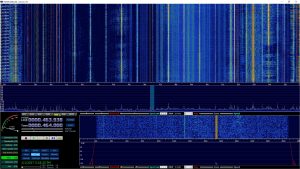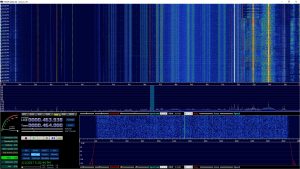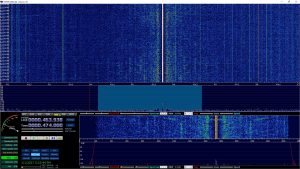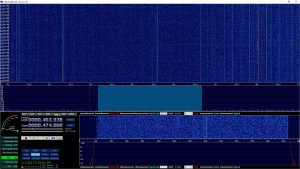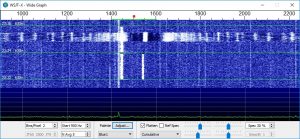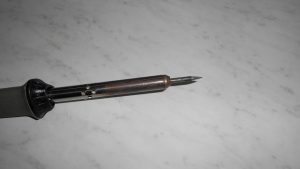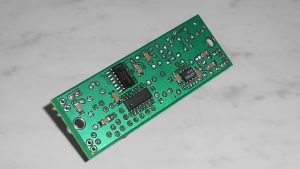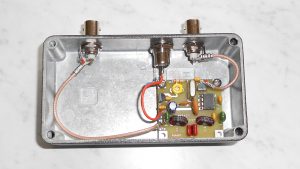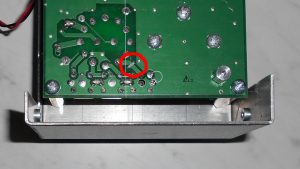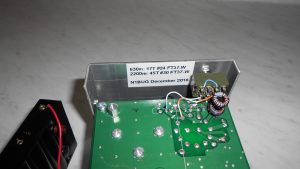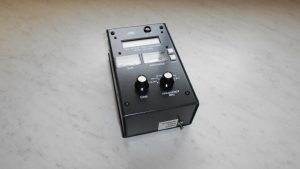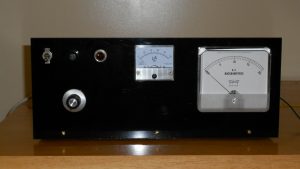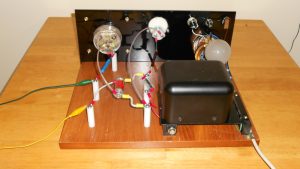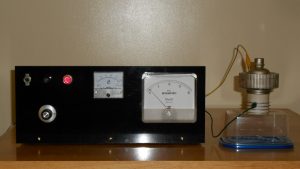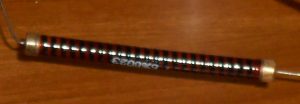This is not intended as a review per se of the SoftRock Lite II with 455 kHz IF option. This is a summary of my experience with the receiver during initial evaluation. My test methods are certainly not standardized and results may be unique to my environment.
The build notes for the kit were often confusing but there were plenty of warnings that one should not expect this to be like assembling a Heathkit with detailed step by step instructions. They sometimes tell you to do something, then in the next paragraph tell you to be sure to do something else before the step they just talked about. I suggest reading ahead before doing anything. There are some typos and inconsistencies. The part about the toroidal transformer I found particularly confusing. They use the terms primary and secondary interchangeably. I found it necessary to read the various links for more information and weigh various statements against others to understand what I was actually supposed to do. I do not feel this is a project for a first time builder.
The oscillator did not work properly without changing one of the bias resistors on Q2. R16 had to be changed from 22.1k to 10k in my case. Reading through the archives of the softrock40 Yahoo group this seems to be a very common issue, yet it is not mentioned in the build notes. I would have preferred to know going in so that I could perhaps decide to mount R16 differently in case it had to be removed later.
Customer service was absolutely outstanding. There was a kit packaging error with the unit we received. When I contacted Tony about it, he was very friendly and immediately mailed the correct packet of parts (the extras needed for the 455 IF option) to me even though I was not the purchaser of the kit, merely the builder.
I suggest heeding the advice about trying the receiver on battery power first. I stupidly connected the test sample to my station’s main 12 volt bus and then spent the better part of two days trying to troubleshoot a receiver that, as it turned out, didn’t have a problem! My 12 volt bus runs many things including some network devices. I discovered during this process that it has about 400 millivolts peak to peak of noise. This manifested as a rather complex AC waveform riding on top of the DC. I don’t know if that was the problem or the fact that connecting to this bus grounds the SoftRock PCB to the station ground, which they warn you not to do. I am not certain exactly how this messed up the SoftRock but the receiver was completely deaf. I could see a lot of noise on the RF signal going into the mixers when I probed it with a scope or spectrum analyzer. The level was also jumping around all over the place. I saw similar noise on the mixer output, and all I could hear from the receiver was a low level buzz. The in-circuit waveforms I saw around the mixer bore a striking resemblance to what I later discovered on the 12 volt bus. The receiver works fine on a 9 volt battery and on an isolated linear wall wart.
What about performance? First of all, this receiver’s sensitivity is excellent, far more than needed for MF operation.
Its local oscillator is more stable than I would have expected. My test setup involves putting a very low level (inaudible) signal into the receiver from my HP 3325B function generator. Drift of the HP is on the order of a couple of milliHertz regardless of environmental changes so it is a reliable standard for this test. I monitored the output of 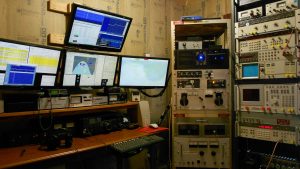 the SoftRock using Argo set to QRSS30, QRSS60, and QRSS 120 in order to get different resolutions. With this setup I can measure drift to better than +/- .01 Hz. Here are a few more details on this setup. I fed signal from the HP 3325B to an unused input on my receive antenna switch. This allowed me to monitor 630 meter WSPR activity using WSJT-X while simultaneously evaluating drift with Argo. I set the injected frequency to 475,900.000 Hz, which is 100 Hz above the top of the WSPR band. Since I was feeding an unused port on the antenna switch, I had some 80 or 90 dB attenuation; thus the minimum output level of the 3325B (-56 dBm) was not a problem. The I and Q outputs from the SoftRock are fed to an HTOmega Claro sound card which can sample at 192 kHz. I used HDSDR for the receiver, piping its output audio through VB Cable to WSJT-X, Argo, and Spectran. The latter was used only as a convenient means of outputting the audio stream to my speakers.
the SoftRock using Argo set to QRSS30, QRSS60, and QRSS 120 in order to get different resolutions. With this setup I can measure drift to better than +/- .01 Hz. Here are a few more details on this setup. I fed signal from the HP 3325B to an unused input on my receive antenna switch. This allowed me to monitor 630 meter WSPR activity using WSJT-X while simultaneously evaluating drift with Argo. I set the injected frequency to 475,900.000 Hz, which is 100 Hz above the top of the WSPR band. Since I was feeding an unused port on the antenna switch, I had some 80 or 90 dB attenuation; thus the minimum output level of the 3325B (-56 dBm) was not a problem. The I and Q outputs from the SoftRock are fed to an HTOmega Claro sound card which can sample at 192 kHz. I used HDSDR for the receiver, piping its output audio through VB Cable to WSJT-X, Argo, and Spectran. The latter was used only as a convenient means of outputting the audio stream to my speakers.
Before making any measurements, I calibrated the LO frequency and front end in HDSDR. The Claro sound card gives more than 100 dB rejection of the image frequency (test conditions: 474.000 kHz input, image around 454 kHz). My other sound card, which is VIA HD audio on the PC motherboard was not as good, providing only about 75 dB image rejection after careful tweaking. It also overloads at a level much lower than the Claro.
With the SoftRock sitting in a typical spot in my shack, cover removed from the Hammond box to allow free air flow, there is a cyclic drift of less than +/- .06 Hz as my furnace cycles and ambient temperature in the shack varies a few degrees. In another location (affected by heat of my rack mounted PC), cover on, cyclic drift associated with furnace activity was +/- 0.15 Hz. When I wrapped the receiver in a towel and stuffed it into a plastic bag the cyclic drift was less than +/- .01 Hz. Lastly I conducted an open air test (cover off) observing frequency change with a 10ᵒF temperature change in the room. it moved 0.7 Hz. Stability of this unit is more than adequate for CW, WSPR, JT9 and other fast or slow modes. Except when wrapped in a towel and plastic bag, drift becomes an issue for super slow modes such ad QRSS30 and slower or DFCW of similar speeds. I believe this can be compensated by using a proportional heater on the SoftRock LO crystal. This is an experiment I plan to try at some point. My station is not in a particularly temperature stable room. Better results may be obtained in other locations. Bear in mind this was a test sample of one, and there may be variation from unit to unit.
There is one major shortcoming of this unit as a 630 meter receiver, and that is its response to signals around the third harmonic of the LO. Remember that we are feeding the mixers with a square wave. Square waves are rich in odd harmonic content. I measured the LO third harmonic (1392 kHz) at 10 dB down from the fundamental 464 kHz. This is a problem since there are many strong signals around 1392 kHz in the middle of the medium wave broadcast band! The SoftRock input filter is only 40 dB down at this frequency. With the LO harmonic at -10 dB and the filter at -40 dB that puts these signals only 50 dB down from its response at the intended frequency, nowhere near enough. Without external filtering, the unwanted response to broadcast stations is a deal breaker at my station. With my outboard bandpass filter in addition to the SoftRock filter, response at 1392 kHz is 105 dB down, still not really enough as some of the stronger stations near the low end of the range (where filter attenuation is less) can still be heard. Bear in mind this is a known issue with simple SDRs of this type and this kit was never intended to be used as a receiver connected to an antenna. It was intended to connect to the IF in a conventional receiver where it would be afforded a great deal of protection by receiver tuned circuits and filters. The 630 meter band itself is “clean” when using my external bandpass filter in conjunction with the SoftRock’s internal filter, but not with the SoftRock alone. (Note: I measured the second harmonic of the LO at -32 dB. If I understand my theory correctly, and that is questionable, I believe the mixer will not respond to signals on even harmonics, making this a non issue. If I am wrong about that, then the second harmonic is also problematic)
Despite most of my receive antennas being down due to storm damage during last night’s test run, the SoftRock did very well receiving 630 meter WSPR activity and one station that was sending “TEST TEST” on CW.
I find the SoftRock Lite II with 455 IF option to be a very promising receiver for 630 meter work but it will need additional band pass, low pass, or medium wave broadcast reject filtering. Without an outboard filter the test unit does a credible job receiving WSPR activity on 630 meters at times. At other times that segment is wiped out by unwanted response to broadcast stations. I strongly recommend that it be used with external filtering. The filter I am using can be built for about $10 (shipping not included) using all new parts. A well stocked junk box could reduce that. More on this to follow in a subsequent post.

